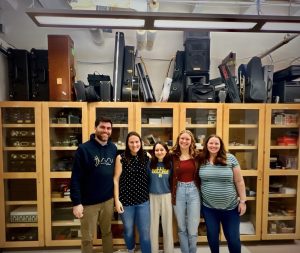Mobile ordering at Rollins has become a popular way for students to place food orders on campus. The system, first introduced during the COVID-19 pandemic, has seen an uptick in issues regarding lengthy wait times as its demand grows with more students on campus.
“We were going to start slowly [with mobile ordering], and then all of a sudden it had to go, like, there tomorrow,” said Associate VP for Finance & Assistant Treasurer Bill Short, who also oversees dining operations for the school.
Rollins started using the Transact Mobile Ordering App amid COVID-19. The original plan was to slowly introduce the app to each dining location, but the need for a no-contact option during the pandemic accelerated this process. Now, the school continues to use the app, and its use has become widespread across the student body.
“The students really love it,” said Short. “That ability to pick up their food and to order in advance.”
In response to the popularity of the app, the school constantly works to accommodate the growing number of students who use it. Among the challenges they face is the significantly large number of orders at the start of the 12:30 p.m. Common Hour on Tuesdays and Thursdays. This is an issue that especially affects Lakeside Grill, also known as the Fox Lodge, as this is the location that receives the greatest number of orders.
“The funny thing about Lakeside is that whether you’re in-person or you order ahead, you’re still using the same application,” said Short.
All students are placed in the same queue, adding to wait times. This is different from other locations, such as Cornell Café, Bush Café, and Dave’s Boathouse, where in-person orders are conducted face-to-face.
Another recent challenge has been the Transact software itself.
“It’s supposed to work and get smarter over time,” said Financial Systems Analyst Alexander Miller. “I think that’s kind of where we’re just working a little bit to see that benefit.”
The issue is suspected to be related to the internet servers. These system issues could be the reason why estimated wait times have recently been much higher than actual wait times.
“Even if that estimated time is not correct, [employees] can manually release the jobs,” said Miller. He added, “I know they’ve been relying on that a lot more as [the system] is learning and still trying to figure out what our peak times are.”
Meanwhile, the school continues to search for other ways to overcome wait time inconveniences. Their main solution is to create greater efficiency in the kitchens through an increase in staff, particularly at Lakeside, where there is often an imbalance between the number of workers and the number of orders placed.
“If you do wait until the class is out to order, you and a thousand of your friends are also doing the exact same thing at that time,” said Short.
To prevent the rush of orders placed at the same time, Rollins is looking into the possibility of scheduling orders in advance. This would help during instances such as common hour when large groups of students place Mobile Orders immediately after leaving class.
Between resolving issues with the Transact software and managing common hour crowds, the school is continuously working to keep mobile orders efficient and easy for all students.





Comments are closed.